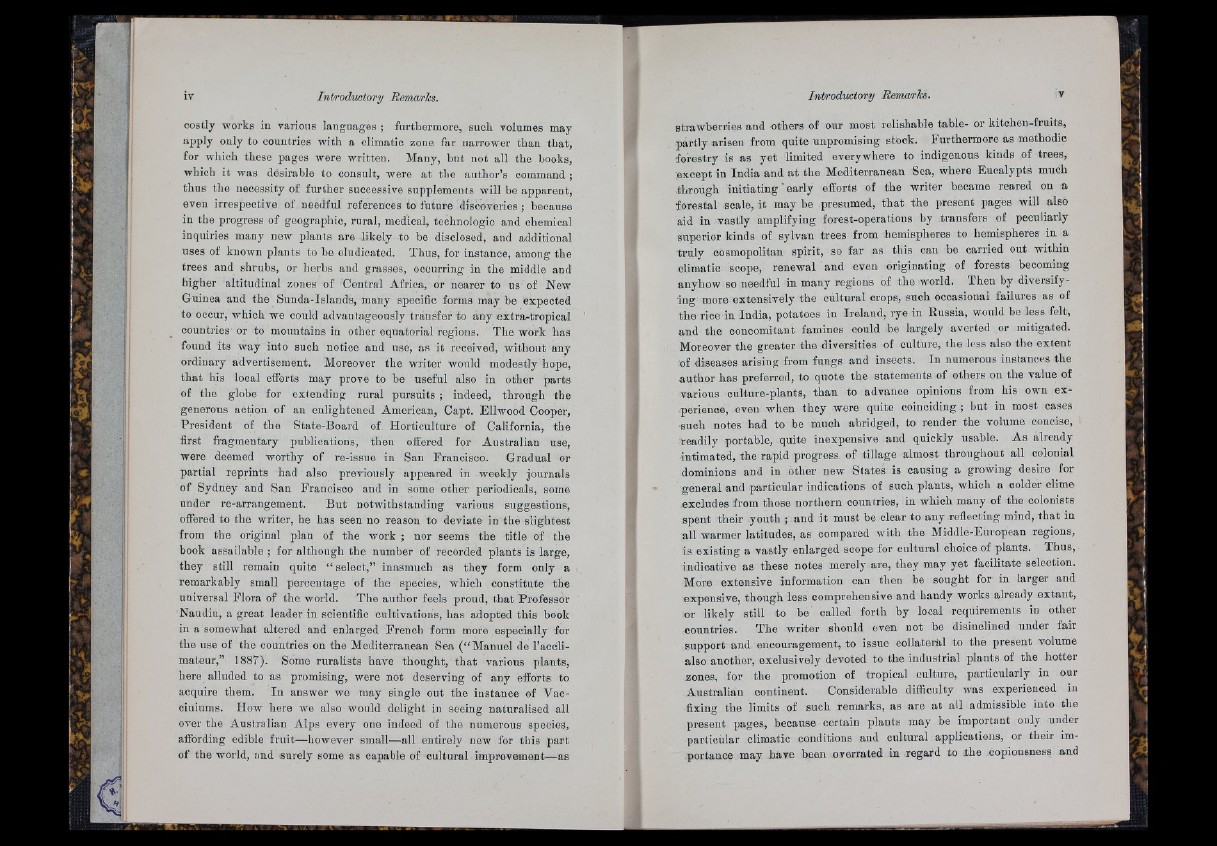
£
V. 'i ’ i
costly works in various languages ; furthermore, such volumes may
apply only to countries with a climatic zone far narrower than that,
for which these pages were written. Many, but not all the books,
which it was desirable to consult, were a t the author’s command ;
thus the necessity of further successive supplements will be apparent,
even irrespective of needful references to future discoveries ; because
in the progress of geographic, rural, medical, technologic and chemical
inquiries many new plants are likely to be disclosed, and additional
uses of known plants to be eludlcated. Thus, for instance, among the
trees and shrubs, or herbs and grasses, occurring in the middle and
higher altitudinal zones of Central Africa, or nearer to us of New
Guinea and the Sunda-Islands, many specific forms may be expected
to occur, which we could advantageously transfer to any extra-tropical
countries or to mountains in other equatorial regions. The work has
found its way into such notice and use, as it received, without any
ordinary advertisement. Moreover the writer would modestly hope,
th a t his local efforts may prove to be useful also in other parts
of the globe for extending rural pursuits ; indeed, through the
generous action of an enlightened American, Capt. Ellwood Cooper,
President of the State-Board of Horticulture of California, the
first fragmentary publications, then offered for Australian use,
were deemed worthy of re-issue in San Francisco. Gradual or
partial reprints had also previously appeared in weekly journals
of Sydney and San Francisco and in some other periodicals, some
under re-arrangeraent. But notwithstanding various suggestions,
offered to the writer, he has seen no reason to deviate in tlie slightest
from the original plan of the work ; nor seems the title of the
book assailable ; for although the number of recorded plants is large,
they still remain quite “ select,” inasmuch as they form only a
remarkably small percentage of the species, which constitute the
universal Flora of the world. The author feels proud, that Professor
Naudin, a great leader in scientific cultivations, has adopted this book
in a somewhat altered and enlarged French form more especially for
the use of the countries on the Mediterranean Sea ( “ Manuel de I’accli-
mateur,” 1887). Some ruralists have thought, th a t various plants,
here alluded to as promising, were not deserving of any efiorts to
acquire them. In answer we may single out the instance of Vac-
ciuiums. How here we also would delight in seeing naturalised all
over the Australian Alps every one indeed of the numerous species,
affording edible fruit—however small—all entirely new for this part
of the world, and surely some as capable of cultural improvement—as
strawberries and others of our most relishable table- or kitchen-fruits,
partly arisen from quite unpromising stock. Furthermore as methodic
forestry is as yet limited everywhere to indigenous kinds of trees,
except in India and a t the Mediterranean Sea, where Eucalypts much
through initiating ■ early efiorts of the writer became reared on a
forestal scale, it may be presumed, th a t the present pages will also
aid in vastly amplifying forest-operations by transfers of peculiarly
superior kinds of sylvan trees from liemispheres to hemispheres in a
truly cosmopolitan spirit, so far as this can be carried out within
climatic scope, renewal and even originating of forests becoming
anyhow so needful in many regions of the world. Then by diversifying
more extensively the cultural crops, such occasional failures as of
the rice in India, potatoes in Ireland, rye in Russia, would be less felt,
and the concomitant famines could be largely averted or mitigated.
Moreover the greater the diversities of culture, the less also the extent
of diseases arising from fungs and insects. In numerous instances the
author has preferred, to quote the statements of others on the value of
various culture-plants, than to advance opinions from his own experience,
even when they were quite coinciding ; but in most cases
such notes had to be much abridged, to render the volume concise,
readily portable, quite inexpensive and quickly usable. As already
intimated, the rapid progress of tillage almost throughout all colonial
dominions and in other new States is causing a growing desire for
general and particular indications of such plants, which a colder clime
excludes from those northern countries, in which many of the colonists
spent their youth ; and it must be clear to any reflecting mind, th a t in
all warmer latitudes, as compared with the Middle-European regions,
is existing a vastly enlarged scope for cultural choice of plants. Thus,
indicative as these notes merely are, they may yet facilitate selection.
More extensive information can then he sought for in larger and
expensive, though less comprehensive and handy works already extant,
or likely still to be called forth by local requirements in other
countries. The writer should oven not be disinclined under fair
support and encouragement, to issue collateral to the present volume
also another, exclusively devoted to the industrial plants of the hotter
zones, for the promotion of tropical culture, particularly in our
Australian continent. Considerable difficulty was experienced in
fixing the limits of such remarks, as are a t all admissible into the
present pages, because certain plants may be important only under
particular climatic conditions and cultural applications, or their importance
may have been overrated in regard to .the copiousness and